

Medium format cameras can be classified by type as well as format. In practical terms the finders are the most important way to classify the cameras. I list all of the types here - though the survey of brands and models is not really complete.
Single Lens Reflex
A single lens reflex is a 'what you see is what you get' camera: by means of a mirror and screen you can see exactly through the lens what will be on film. Not only framing and perspective, but also focus and depth of field.
SLR systems usually have many lenses, from wide angle to telephoto, from macro to zoom.
Well known cameras in the 6x4.5 format: the Bronica ETR series, Contax 645, Pentax 645(n), Mamiya 645 series and the Hasselblad H1 (not to be confused with their famous 6x6 series!). Apart from Bronica these systems all have autofocus models.
6x6 format is used by the Bronica SQ series (and the older S2A and EC series), the Hasselblad 500 and 200 series and the Rollei 6000 series (as well as the older SL66). There are also East-European models as well: Pentacon and Kiev 60 and 88.
The Bronica GS, Mamiya RB and RZ and the Pentax 67 (different models) all use the 6x7 format.
The largest SLR is the Fuji 680, which is actually a combination of a SLR and a view camera. Its format is, as you might have guessed, 6x8.
Twin Lens Reflex
A TLR has two lenses: one for the finder, with a mirror and screen, and one that actually takes the photograph. Focusing is done the same way as with a SLR. Depth of field cannot be seen though. Close-up shots are a bit difficult, as the finder lens sees over the subject. Without special accessories close-up work (say within 1 meter) is not really possible.
As the mirror doesn't have to move just before the shot, a TLR is very silent and
unobtrusive.
Apart from a few rare exceptions, TLR all have the 6x6 format. They are almost always used with a waist level finder.
Well known are the Rolleiflexes and Rolleicords. Many Japanese brands made TLRs as well, like Yashica and Minolta.
The only brand that made a TLR with changeable lenses is Mamiya. It had a whole series of models (C2 and C3 to C220 and C330).
Rangefinder
Rangefinder cameras have their finders at the top right of the camera. An optical mechanism makes a split-image and the image in the finder combine, as you turn the focussing ring on the lens. As soon as the two images are the same, the image is precisely in focus. This type of camera isn't really fit for close-up, and cannot be used at all for real macro work. A telephoto lens of more than 2x normal focal length cannot be made.
As there is no mirror to move, the camera works almost silently. Some cameras have interchangeable lenses, others have a fixed focal length, either normal or wide-angle. The camera is lighter than a SLR of the same film size.
There are range finders in all formats:
Fuji had a series of 6x4.5 camera with fixed focal lengths. Quite recently Bronica introduced one with interchangeable lenses.
Mamiya had a 6x6 range finder with 3 lenses. Soon they developed a 6x7, with a wider range of optics. Both ranges go from wide-angle to telephoto.
Fuji had until very recently 6x7 and 6x9 models with a fixed normal and with a fixed wide-angle.
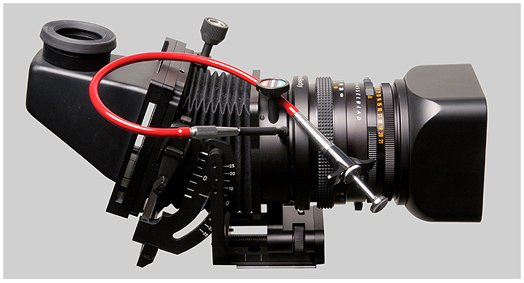
There are some View Camera in the 6x9 format. There is also a Hasselblad Flexbody, using the backs and lenses of the Hasselblad 500 series. However, many photographers prefer a 4x5" (9x12cm) View Camera and roll film backs.
As the uses of these cameras are a bit outside the 'normal' medium format, I won't discuss them in detail. More information on these magnificent and powerful tools can be found on large format photography.
Cameras without a focussing finder
Some medium format cameras do have a finder, which can be used for framing, but not for focussing. These are mainly panoramic cameras. Often a separate ground glass (screen) can be used to focus, unless the camera is loaded with film.
Cameras like this include the Horseman and Linhof 6x12 cameras and the Fuji and Linhof 6x17 cameras.
Being used to 35mm, it can be quite a shock to see
how easily most medium format cameras can be taken apart. I am not talking about screwdrivers here! SLRs in particular are part of a modular system: parts that cannot be taken apart in 35mm cameras, can be in medium format. Lovely if you like do-it-yourself.
A survey:
camera body
The camera's central part is the body - the camera itself. SLRs have a mirror here, a large part of the camera's mechanical system and with electronic cameras the electronics. It depends on the model whether the shutter times are selected on the camera or on the lenses.
Cameras sporting a focal plane shutter have their shutter in the body. Systems with leaf shutter lenses have some sort of extra shutter to prevent light peeping along the mirror on to the film.
backs
SLRs (older Mamiyas 645, Pentaxes 645 and 67, Rollei SLX, Pentacon and Kiev 60 excepted!) and view cameras have backs, that allow you to switch film (or digital) without loosing any frame. All you need is another back with the film you want to use. There is no need to finish the old film first before using another one. Very nice if you use film of different speed or if you want to shoot a subject in both colour and black & white. Just change backs! No need to take a second camera with you (although a back-up camera is indispensable for professional jobs) or to waste perfectly good film.
Backs exist for 120 and 220 film and for Polaroid! Such a back comes in handy when you want to check a lighting set-up. So this tool is mainly used in studios or elsewhere when artificial light is used. And when you have got an art director looking over your shoulder...
Recent years have seen the arrival of digital backs. Most recent medium format cameras with interchangeable backs can accept digital backs as well. This way they are easily turned into a digital camera.
The entrance costs to medium format digital are as high as the quality is! At the time of writing (November 2003) these backs are affordable to professionals (in specific fields) only.
finders
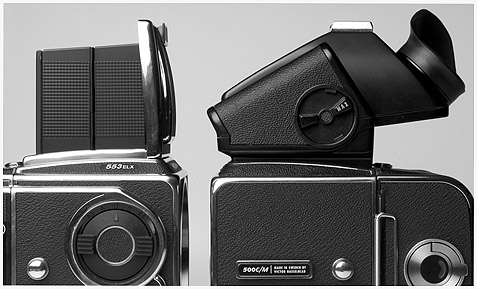 All 35mm and digital SLRs sport a prism. This finder enables the photographer to see the image correctly with the left of the subject at the left, the right to the right. You can see through this finder at the back of the camera.
All 35mm and digital SLRs sport a prism. This finder enables the photographer to see the image correctly with the left of the subject at the left, the right to the right. You can see through this finder at the back of the camera.
A lot of medium format cameras are sold with a so called waist level finder - a foldable black box around the ground glass. This way you can look at the image with both eyes, looking at the camera from above. Composition and framing can be examined very precisely. A disadvantage is that the left and right sides of the subject are shown reversed. This makes this kind of finder a bad choice for action photography!
A waist level finder can only be used (in practical terms) on cameras that don't need to be turned for upright shots. In other words: all 6x6 cameras and the Mamiya RB and RZ, which sport
reversible backs.
All waist level finders have a folding loupe, that enables the photographer to focus more precisely. There is no way though, to view the composition with both eyes this way.
Many photographers prefer viewing from behind the camera instead of on top of it. A higher point view is a real bonus when shooting large groups or some types of landscape work. And they prefer a non-reversed image to one where left is right and vice versa!
And that is what a prism finder is for, the same as are used in 35mm SLRs. A lot of medium formats have prisms in two flavours: one with and one without light metering. Of course cameras that have metering within the body, don't need such a meter in a prism (Rollei 6000 and Hasselblad 200 series).
And then there is the choice between a 90 and a 45 degrees prism. The latter makes you view from behind and above; this type is often brighter (and I myself like the fact very much that I don't need to get through my knees and bow my head in a religious way, just to get a picture from a lower point of view).
And then there are the so-called rigid finders. These are viewed from above (like the waist level finder), and have a higher magnification loupe, for even more precise focusing.
These finders cannot be folded.
ground glass viewing screens
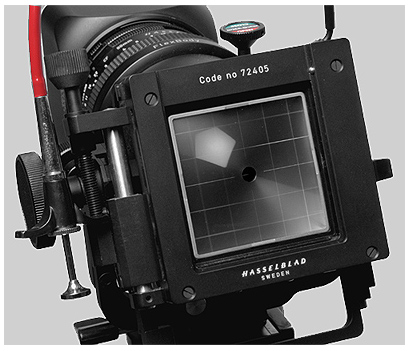
A medium format camera user can choose a ground glass as well as a finder. Some of these are made for specialist uses (like astrophotography, extreme macro) others have a wider use. A good one for architecture and reproduction purposes is a screen with a grid pattern.
For focusing one can opt for a screen with microprism with or without a 'split range finder'.
winders
Some medium format cameras have a built-in winder (for instance the Contax and Pentax 6x4.5, the Rollei 6000 series and the Fuji auto focus 6x4.5 fixed lens cameras). For many others a separate winder can be bought.
Most cameras have such a winder at their right side. Most of these have their own shutter release buttons.
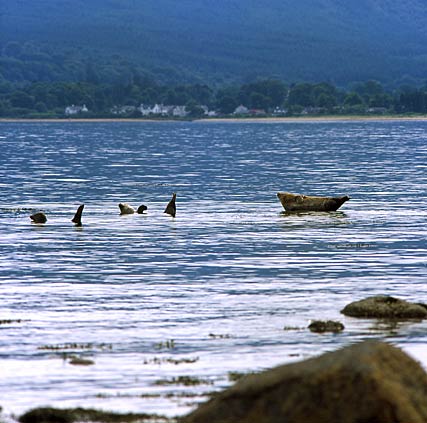
The number of lenses available for medium format systems is (usually) smaller than with their 35mm sisters. Ultra wide-angle and real telephoto monsters are rare. There are a number of zoom lenses available, but their popularity is smaller than in 35mm photography.
Medium format lenses tend to be slower than their 35mm counterparts. 2.0 is very fast for a standard lens. Because of their longer focal lengths, their depth-of-field is also smaller. Therefore the maximum apertures are harder to use.
An important difference to 35mm is that many medium format lenses sport a leaf shutter, whereas all 35mm interchangeable lens systems have the shutters in the camera (focal plane shutter).
This has, with the disadvantage of some more weight and a higher price, two advantages. Flash can be used with all shutter speeds, whilst a medium format focal plane shutter tends to have a slow synchronisation time, like 1/60 sec. And a leaf shutter is quieter and causes less vibration.
Focal plane camera systems often have a small series of leaf shutter lenses.
One thing that seems hard to get use to for experienced 35mm shooters, is the comparison of focal lengths. Because the film area is larger in medium format, the focal lengths need to be longer for the same angle of view.
Because the width to length ratio differs according to the specific formats, the following table is a mere indication.
| 35mm | 6x4.5 | 6x6 | 6x7 | 6x9 |
| 21 | 35 | 40 | 45 | 50 |
| 28 | 45 | 50 | 55 | 65 |
| 35 | 55 | 60 | 70 | 80 |
| 45 | 75 | 80 | 90 | 105 |
| 90 | 135 | 150 | 180 | 210 |
| 135 | 230 | 250 | 270 | 320 |
| 180 | 270 | 300 | 360 | 420 |
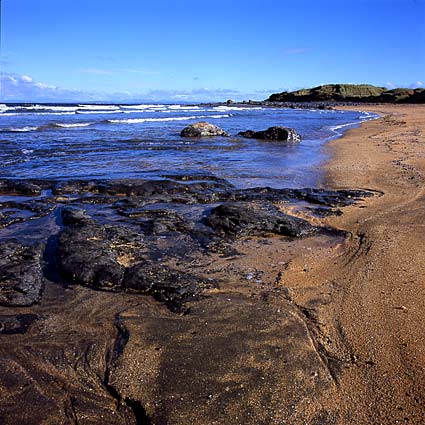
Just like 35mm systems, medium format cameras have all kinds of accessories, for instance extension tubes, bellows, filters, hoods etc. As these items are not unique to medium format, I won't cover them here.
- Scotland, camping with a Bronica 6x6 the Bronica EC and my way of working. Published in Camera Magazine # 3/2002.
- Rollei 6008
This article is written by Wim van Velzen, © 2003.
Comments on the article and photographs are welcome!The landscape photographs shown here and lots more are put in several portfolios! More wedding photos can be found in the wedding galleries.
It is also possible to order landscape prints or to use them editorially or commercially.